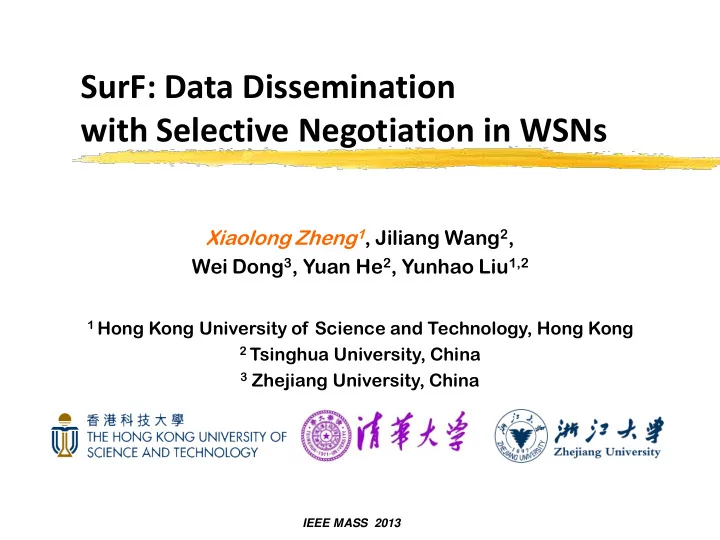

SurF: Data Dissemination with Selective Negotiation in WSNs Xiaolong Zheng 1 , Jiliang Wang 2 , Wei Dong 3 , Yuan He 2 , Yunhao Liu 1,2 1 Hong Kong University of Science and Technology, Hong Kong 2 Tsinghua University, China 3 Zhejiang University, China IEEE MASS 2013
Roadmap Background & Motivation -- Flooding VS Negotiation -- Motivation Protocol Design -- Overview of SurF -- Best strategy estimation -- State transition Experimental Evaluation -- Experimental Settings -- Experimental Results Conclusion 1
Background Data dissemination Data dissemination is a core building block in WSNs. General scenario: Reliably disseminate data over a multi-hop sensor network from sink to all the other nodes. Sink Central Server 2
Background Flooding Flooding is a way to do data dissemination. A 2 1 Sink 2 D B 1 2 1 E 2 1 No guarantee for reliability 2 1 C Blind retransmissions F 2 1 3
Background Negotiation-based methods Negotiation is a mechanism for reliability and efficiency by a three-way handshake. A 2 1 Sink 2 D B 2 1 2 1 ADV: advertisement E 2 1 1 2 REQ: request C DATA: data messages F 1 2 4
Motivation Negotiation Advantages : Guarantees the reliability by using REQ as NACK Avoid blind retransmissions Disadvantages: Incurs additional control messages Prolongs the completion time 5
Motivation Key question: Is negotiation always necessary? A A 2 1 Sink 1 2 Sink 2 2 B B 1 2 2 1 C C 1 2 1 2 0 ADV + REQ + DATA 0 2 1 2 0 1 0 1 1 1 0 ADV + REQ + DATA 0 2 Key idea: Selectively use the negotiation only when necessary 6
Protocol Design Overview of SurF (Sur vival of the F ittest ) Design Issue 1: Accurate estimation for minimizing the completion time Design Issue 2: Efficient and reliable state transition 7
Best Strategy Estimation Best strategy estimation problem: Minimizing the completion time of data dissemination, given the information of neighboring nodes. Strategy alternation: flooding <--> negotiation Best transition point deciding problem: Deciding the optimal transition point from flooding to negotiation. 8
Best Strategy Estimation Deciding the best transition point: Deciding the times of flooding (n) for minimum completion time. n: number of rebroadcasting # 𝒑𝒈 𝒔𝒇𝒅𝒇𝒋𝒘𝒇𝒆 𝒒𝒃𝒅𝒍𝒇𝒖𝒕 𝑺𝒇𝒃𝒎𝒋𝒄𝒋𝒎𝒋𝒖𝒛 = # 𝒑𝒈 𝒒𝒃𝒅𝒍𝒇𝒖𝒕 𝒖𝒊𝒃𝒖 𝒃𝒔𝒇 𝒇𝒚𝒒𝒇𝒅𝒖𝒇𝒆 𝒖𝒑 𝒔𝒇𝒅𝒇𝒋𝒘𝒇 9
Best Strategy Estimation Deciding the best transition point: We model the completion time of dissemination in single hop. Thus, each node can decide its times of flooding in distributed manner. 𝑈 𝑜𝑓𝑝𝑢𝑗𝑏𝑢𝑗𝑝𝑜 , 𝑜 = 0 ; ′ 𝑜 × 𝑈 𝑔𝑚𝑝𝑝𝑒𝑗𝑜 + 𝑈 𝑜𝑓𝑝𝑢𝑗𝑏𝑢𝑗𝑝𝑜 , 0 < 𝑜 < 𝑂 𝐺 ; 𝑈(𝑜) = 𝑂 𝐺 × 𝑈 𝑜 = 𝑂 𝐺 ; 𝑔𝑚𝑝𝑝𝑒𝑗𝑜 , n : times of flooding N F : times of flooding needs to achieve the required reliability 10 10
Best Strategy Estimation Deciding the best transition point: We model the completion time of dissemination in single hop. Thus, each node can decide its times of flooding in distributed manner. 11 11
State Transition Efficient and reliable state transition: A receiver should be aware of the strategy that the sender adopts to cooperate with the sender. Efficient transition: Active notification of sender’s transition Reliable transition: Periodical ADV messages to announce the transition 12 12
Protocol Design Method in flooding phase: Probabilistic flooding mitigating collision by random back-off scheme Random back-off time: 10-25ms Reducing the redundancy by probabilistic rebroadcasting Rebroadcasting probability: 0.9 initially and adjusted during the process Method in negotiation phase: Deluge 13 13
Roadmap Background & Motivation -- Flooding VS Negotiation -- Motivation Protocol Design -- Overview of SurF -- Best strategy estimation -- State transition -- Strategies Experimental Evaluation -- Experimental Settings -- Experimental Results Conclusion 14 14
Experimental Evaluation Environmental settings: Platform: TelosB / TinyOS 2.1.1 Network size: 5 × 8 Power: level 1 Data size: 1~10K Bytes Metric: completion time & energy 15 15
Experimental Evaluation Evaluation Result: Shorter completion time compared to Deluge 16 16
Experimental Evaluation Evaluation Result: How does SurF reduce completion time? 17 17
Experimental Evaluation Evaluation Result: How well does flooding perform in SurF? Complete 60% of data dissemination in only 15% of the total time! 18 18
Experimental Evaluation Evaluation Result: Completion time VS data size 19 19
Conclusion Fast Data Dissemination: • Negotiation scheme is necessary for reliability • Selectively adopts negotiation instead of during the whole process • Reduces the unnecessary negotiation for shorter completion time Key Observation: • The negotiation is not always necessary during the whole process. • Flooding is not totally destructive to data dissemination. • The hybrid schemes can make use of the advantages while avoid their weaknesses. 20 20
Q & A Thank nk You! 21 21
Recommend
More recommend